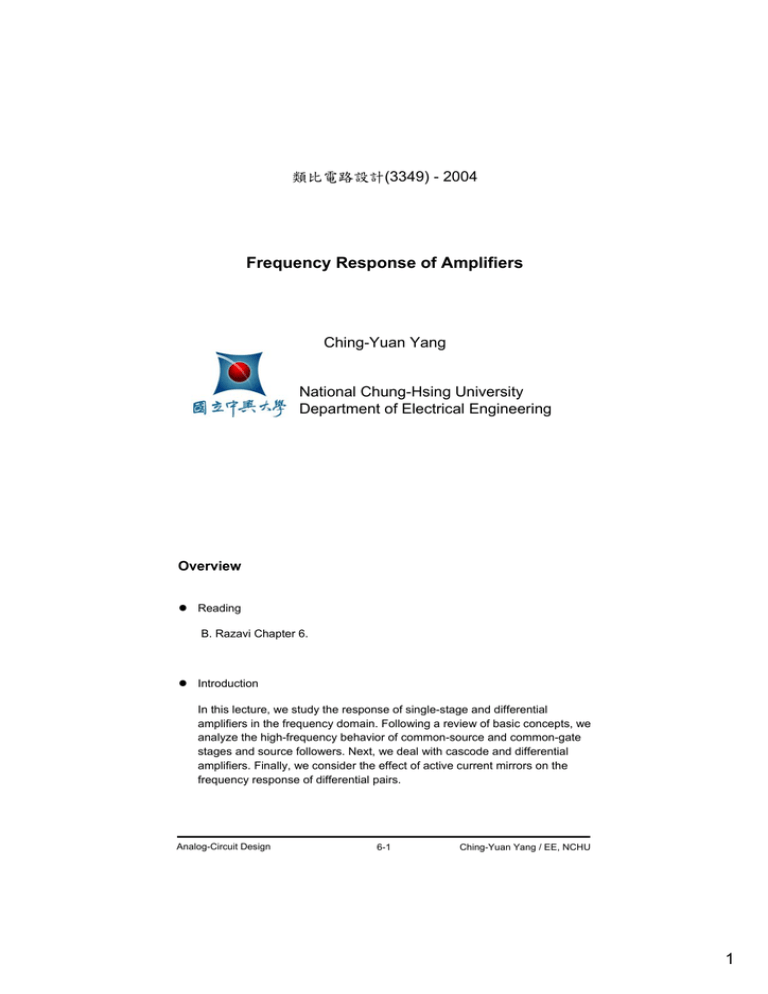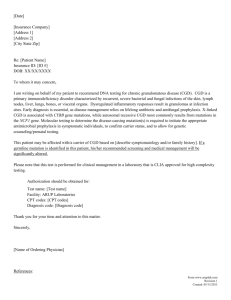Frequency Response of Amplifiers
advertisement

類比電路設計(3349) - 2004 Frequency Response of Amplifiers Ching-Yuan Yang National Chung-Hsing University Department of Electrical Engineering Overview z Reading B. Razavi Chapter 6. z Introduction In this lecture, we study the response of single-stage and differential amplifiers in the frequency domain. Following a review of basic concepts, we analyze the high-frequency behavior of common-source and common-gate stages and source followers. Next, we deal with cascode and differential amplifiers. Finally, we consider the effect of active current mirrors on the frequency response of differential pairs. Analog-Circuit Design 6-1 Ching-Yuan Yang / EE, NCHU 1 Miller effect z Application of Miller effect to a floating impedance That is, Z Z1 = V 1− Y VX Z 2 = Z V 1− X VY V X − VY V X = Z Z1 VY − V X = VY Z2 Z Analog-Circuit Design Ching-Yuan Yang / EE, NCHU 6-2 Association of poles with nodes z Cascade of amplifiers The overall transfer function can be written as A2 1 Vout A1 (s ) = ⋅ ⋅ 1 + RSCin s 1 + R1CN s 1 + R2C P s Vin We may say “each node in the circuit contributes one pole to the transfer function.” The pole is determined by the total capacitance seen from each node to ground multiplied by the total resistance seen at the node to ground. In general, the transfer function is given as A Vout (s ) = ∏ js = Av ∏ 1 s j j Vin 1+ 1+ ωj ωj −1 where each pole with one node of the circuit, i.e., ω j = τ j , where τj is the product of the capacitance and resistance seen at node j to ground. Analog-Circuit Design 6-3 Ching-Yuan Yang / EE, NCHU 2 Common-source stage z High-frequency model of a CS stage (Assume λ = 0 and M1 operates in saturation) At the input node, the total capacitance seen from X to ground is equal to Cin = CGS + (1 − Av)CGD, where Av = − gmRD. The input pole is ωin = RS [CGS (Miller multiplication) 1 + (1 + gm RD )CGD ] At the output node, the total capacitance seen to ground is equal to Cout = CDB + (1 − Av−1)CGD ≈ CDB + CGD The input pole is ωout = 1 RD (C DB + CGD ) Analog-Circuit Design Ching-Yuan Yang / EE, NCHU 6-4 Common-source stage (cont’d) z Model for calculation of output impedance (If RS is relative large, the effect of RS is neglected.) The output pole: Z X = where Ceq = C + CGS 1 1 || GD ⋅ Ceq s CGD gm1 CGDCGS CGD + CGS Thus, the output pole is roughly equal to ωout = Finally, we surmise that the transfer function is Analog-Circuit Design 6-5 RD 1 CGD + CGS 1 (Ceq + C DB ) ⋅ gm1 CGD Vout − gm RD (s ) = Vin s s 1 + 1 + ω ω in out Ching-Yuan Yang / EE, NCHU 3 Common-source stage (cont’d) z Equivalent circuit of CS stage V X − Vin + V X CGS s + (V X − Vout )CGD s = 0 RS (V − V )C s + g V + V 1 + C s = 0 X GD m X out DB out RD ⇒ zero (CGD s − gm )RD Vout (s ) = Vin RS RDξs 2 + [RS (1 + gm RD )CGD + RSCGS + RD (CGD + C DB )]s + 1 poles where ξ = CGSCGD + CGSCDB + CGDCDB. Note the transfer function is of second order even through the circuit contains three capacitors. While the denominator appears rather complicated, it can yield intuitive expressions for the two poles, ωp1 and ωp2, if we assume |ωp1|<< |ωp2|. Writing the denominator as s s 1 1 s2 D = + 1 + 1 = + + s + 1 ω ω ω ω ω ω p1 p 2 p2 p1 p 2 p1 Analog-Circuit Design Ching-Yuan Yang / EE, NCHU 6-6 Common-source stage (cont’d) If ωp2 is much farther from ωp1 (i.e., |ωp1| << |ωp2|), then D= ≈ s2 ω p1ω p 2 s2 ω p1ω p 2 1 1 + + s + 1 ω ω p 1 p2 1 + s +1 ω p1 We obtain ω p1 = ω p2 = 1 RS (1 + gm RD )CGD + RSCGS + RD (CGD + C DB ) 1 ⋅ 1 ω p1 RS RD (CGSCGD + CGSC DB + CGDC DB ) If RD(CGD + CDG) is negligible, then ω p1 ≈ = RS (1 + gm RD )CGD + RSCGS + RD (CGD + C DB ) RS RD (CGSCGD + CGSCDB + CGDC DB ) 1 = ωin RS [CGS + (1 + gm RD )CGD ] If CGS >> (1 + gmRD)CGD + RD(CGD + CDB)/RS , then ω p 2 ≈ Analog-Circuit Design 1 RSCGS = = ωout RS RD (CGSCGD + CGSC DB ) RD (CGD + C DB ) 6-7 Ching-Yuan Yang / EE, NCHU 4 Common-source stage (cont’d) z Feedforward path through CGD The transfer function exhibits a zero given by ωz = +gm/CGD. Located in the right half plane, the zero arises from direct coupling of the input to the output through CGD at very high frequency. Note that a zero in the right half plane introduces stability issues in feedback amplifiers Analog-Circuit Design 6-8 Ching-Yuan Yang / EE, NCHU Common-source stage (cont’d) z Calculation of the zero in a CS stage Zero: Vout (s ) =0 s = sz Vin For a finite Vin, this means that Vout(sz) = 0 and hence the output can be shorted to ground at the frequency with no current. Therefore, the currents through CGD and M1 are equal and opposite: V1CGD sz = gmV1. That is , sz = +gm/CGD. Analog-Circuit Design 6-9 Ching-Yuan Yang / EE, NCHU 5 Common-source stage (cont’d) z Input impedance At high frequency, the effect of the output node must be taken into account. I RD (I X − gmV X ) + X = VX 1 + RDC DB s CGD s ⇒ ZX = 1 + RD (CGD + C DB )s VX = I X CGD s (1 + gm RD + RDC DB s ) 1 CGS s At frequencies where |RD(CGD + CDB)s| << 1 and |RDCDBs| << 1 + gmRD, 1 ZX = , indicating that the input (1 + gm RD )CGD s hence Z in = Z X impedance is primarily capacitive. In fact, if CGD is large, it provides a low-impedance path between the gate and drain of M1, yielding the equivalent circuit that 1/gm1 and RD appear in parallel with the input. Analog-Circuit Design 6-10 Ching-Yuan Yang / EE, NCHU Source followers z Source follower V1CGS s + gmV1 = VoutC L s Vin = RS [V1CGS s + (V1 + Vout )CGD s ] + V1 + Vout Transfer function: Vout gm + CGS s (s ) = Vin RS (CGSC L + CGSCGD + CGDC L )s 2 + (gm RSCGD + C L + CGS )s + gm Zero: The transfer function contains a zero in the left half plane. This is because the signal conducted by CGS at high frequencies adds with the same polarity to the signal produced by the intrinsic transistor. Poles: If the two poles of the transfer function are assumed far apart, then the domain pole is 1 gm ω p1 ≈ = gm RSCGD + C L + CGS R C + C L + CGS S GD gm Also, if RS = 0, then ωp1 = gm / (CL + CGS ) . Analog-Circuit Design 6-11 Ching-Yuan Yang / EE, NCHU 6 Source followers (cont’d) z Input impedance CGD is ignored, we have VX = 1 IX g I 1 + I X + m X CGS s CGS s gmb C L s ∴ Z in = 1 1 VX g = + 1 + m I X CGS s CGS s gmb + C L s At relative low frequencies, gmb >> |CLs| and 1 g 1 1 1 1 + m + = + CGS s gmb gmb gmb gmb CGS s gm + gmb indicating that the equivalent input capacitance is equal to CGSgmb / (gm + gmb ). By Miller approximation: The low-frequency gain Av = gm / (gm + gmb ) Z in ≈ Thus, Ceq = CGS (1 − Av ) = CGSgmb / (gm + gmb ), and Cin ,total = CGD + At high-frequencies, gmb << |CLs| and Z in ≈ Analog-Circuit Design 1 1 gm + + CGS s C L s CGSC L s 2 6-12 CGS gmb gm + gmb Negative resistor Ching-Yuan Yang / EE, NCHU Source followers (cont’d) z Output impedance CGD is neglected, V1CGS s + gmV1 = − I X V1CGS sRS + V1 = −V X ⇒ Z out = V X RSCGS s + 1 = IX gm + CGS s At low frequencies, Zout ≈ 1/gm. At very high frequencies, Zout ≈ RS, because CGS shorts the gate and source. 1 > RS gm Analog-Circuit Design 1 < RS gm 6-13 Ching-Yuan Yang / EE, NCHU 7 Source followers (cont’d) z Equivalent output impedance of a source follower If Z1 = Zout, find R1, R2 and L: Take R2 = 1/gm, R1 = RS − 1/gm, then Z out 1 − = gm 1 ⇒ Z out − ⇒ 1 CGS s RS − gm gm + CGS s L= 1 gm CGS gm = 1 RS − 1 gm + 1 1 1 = + CGS s 1 R1 Ls RS − gm gm 1 RS − gm That is, the dependence of L upon RS implies that if a source follower is driven by a large resistance, then it exhibits substantial inductive behavior. Analog-Circuit Design 6-14 Ching-Yuan Yang / EE, NCHU Common-gate stage z CG stage at high frequencies ωin = CS RS −1 1 , where C = C + C S GS SB gm + gmb ωout = ( RDCD )−1, where CD = CDG + CDB At low frequency, Av = (gm + gmb )RD 1 + (gm + gmb )RS (gm + gmb )RD 1 Thus, Vout (s ) = Av ⋅ = Vin s s 1 + (gm + gmb )RS 1 + 1 + ωin ωout 1 CS 1 + s (1 + RDC D s ) gm + gmb + RS−1 An important property of CG stage is that it exhibits no Miller multiplication of capacitances, potentially achieving a wide band. z Input impedance Z in ≈ ZL (gm + gmb )ro + 1 1 , where Z L = RD CDs gm + gmb Since Zin now depends on ZL, it is difficult to associate a pole with the input node. Analog-Circuit Design 6-15 Ching-Yuan Yang / EE, NCHU 8 Common-gate stage (cont’d) z CG stage Transfer function: (− VoutC L s + V1Cin s )RS + Vin = −V1 ro (− VoutC L s − gmV1 ) − V1 = Vout ⇒ Vout 1 + gmro (s ) = Vin roC LCin RS s 2 + [roC L + Cin RS + (1 + gmro )C L RS ]s + 1 The gain at low frequencies is equal to 1 + gmro. Input impedance: 1 1 1 Z in = + ⋅ gm + gmb C L s (gm + gmb )ro As CL or s increases, Zin approaches 1/(gm + gmb ) and hence the input pole can be defined as ω p ,in = 1 1 Cin RS gm + gmb Analog-Circuit Design 6-16 Ching-Yuan Yang / EE, NCHU Cascode stage z High-frequency model of a cascode stage Cascode stage = CS stage (input impedance) + CG stage (suppressing the miller effect) Gain: VX gm1 ≈− VA gm 2 + gmb 1 g m1 CGD1 RS CGS1 + 1 + gm 2 + gmb Node A: ω p ,A = Node X: ω p,X = gm 2 + gmb2 gm 2 + gmb2 CGD1 + CDB1 + CSB 2 + CGS 2 1 + gm1 Node Y: ω p ,Y = 1 RD (C DB 2 + C L + CGD 2 ) In actual design, ωp,X is typically chosen to be farther from the origin than the other two. This choice plays an important role in the stability of op amps. Analog-Circuit Design 6-17 Ching-Yuan Yang / EE, NCHU 9 Cascode stage (cont’d) z Simplified model of a cascode stage with a current source VX = −(VoutCY s + Iin) / (CX s) ID2 = −gmVGS2 = gm2VX = − gm2 (VoutCY s + Iin) / (CX s) g 1 − ro 2 (VoutCY s + I in ) m 2 + VoutCY s − (VoutCY s + I in ) = Vout C s C X Xs Vout g r +1 1 ⇒ = − m2 o2 ⋅ C I in CXs 1 + (1 + gm 2ro 2 ) Y + CY ro 2s CX for gm2ro2 >> 1 and gm2ro2CY /CX >> 1 (i.e., CY > CX ), g 1 Vout ≈ − m2 C X s CY g + C s I in m2 Y CX hence g g Vout I in Vout 1 = ≈ − m1 m 2 Vin Vin I in CY C X s gm 2 /C X + s We can find that the pole at node X is given by gm2 / CX . Neglecting CGD1 and CY, we have Zout = (1 + gmro2)ZX + ro2, where ZX = ro1||(CX s)−1. Analog-Circuit Design 6-18 Ching-Yuan Yang / EE, NCHU Differential pair z Half-circuit equivalent z Differential pair z Equivalent circuit for common-mode input Av ,CM 1 ∆gm RD C L s =− (gm1 + gm 2 ) ro 3 1 + 1 CP s If the output pole is much farther from the origin than is the pole at node P, the common-mode rejection of the circuit degrades considerably at high frequencies. Analog-Circuit Design 6-19 Ching-Yuan Yang / EE, NCHU 10 Differential pair (cont’d) z Effect of high-frequency supply noise in differential pair If the supply voltage contains high-frequency noise and the circuit exhibits mismatches, the resulting common-mode distance at node P leads to a differential noise component at the output. A trade-off between voltage headroom and CMRR: To minimize the headroom consumed by M3, its width is maximized, introducing substantial capacitance at the sources of M1 and M2 and degrading the high-frequency CMRR. The issue becomes more serious at low supply voltages. Analog-Circuit Design Ching-Yuan Yang / EE, NCHU 6-20 Differential pair (cont’d) z Differential pair with current-source loads Node G is an ac ground. The output pole is given by ωout = Analog-Circuit Design 1 (ro1 ro 3 )C L 6-21 , the dominant pole. Ching-Yuan Yang / EE, NCHU 11 Differential pair (cont’d) z High-frequency behavior of differential pair with active current mirror Mirror pole: ω p ,E = gm 3 , where CE denotes the total capacitance at E to ground. CE CE: CGS3, CGS4, CDB3, CDB1, and the miller effect of CGD1 and CGD4. Analog-Circuit Design 6-22 Ching-Yuan Yang / EE, NCHU Differential pair (cont’d) z High-frequency model of differential pair with active current mirror Thevenin equivalent: VX = gmN roN Vin, RX = 2roN. Assumed 1/gmP << roP , VE = (Vout 1 C E s + gmP − VX ) 1 + RX C E s + gmP ( ) and − gm 4VE − I X = Vout C L s + roP−1 , we have Vout gmN roN (2gmP + CE s ) = Vin 2roP roN CEC L s 2 + [(2roN + roP )C E + roP (1 + 2gmProN )C L ]s + 2gmP (roN + roP ) Since the miller pole is typical quite higher in magnitude than the output pole, we get ω p1 ≈ (2roN and ω p 2 ≈ 2gmP (roN + roP ) 1 ≈ (roN roP )C L for 2gmProN >> 1 + roP )CE + roP (1 + 2gmProN )CL gmP . CE Analog-Circuit Design 6-23 Ching-Yuan Yang / EE, NCHU 12 Differential pair (cont’d) In addition, there is a zero with a 2gmP in the left half CE magnitude of plane. The appearance of such a zero is that the circuit consists of a “slow path” (M1, M3 and M4) in parallel with a “fast path” (M1 and M2). Representing the two paths, we have Vout A0 A0 = + (1 + s /ω p1 )(1 + s /ω p 2 ) 1 + s /ω p1 Vin = A0 (2 + s /ω p 2 ) (1 + s /ω p1 )(1 + s /ω p 2 ) That is, the system exhibits a zero at 2ωp2. Analog-Circuit Design 6-24 Ching-Yuan Yang / EE, NCHU Differential pair (cont’d) z Determine the zero (method) ID4 IL For zero frequency, IL = 0 and ID4 = IX. We have ID4 = −gmPVE IX = VE (gmP + CE s) Thus, −gmPVE = VE (gmP + CE s) ωz = − 2gmP CE Analog-Circuit Design 6-25 Ching-Yuan Yang / EE, NCHU 13


